
IM7580AIM7581IM7583IM7585 IM7587 IMPEDANCE ANALYZER
Instruction Manual
EN
Sept. 2018 Revised edition 4
IM7585A981-04 18-09H
IM7583
IM7583-01
IM7583-02
IM7585
IM7585-01
IM7585-02
IM7580A
IM7580A-1
IM7580A-2
IM7581
IM7581-01
IM7581-02
IMPEDANCE ANALYZER
IM7587
IM7587-01
IM7587-02
Instruction Manual


i
4 Analyzer Function 59
4.1 Analyzer Function .......................... 59
4.1.1 Flowchart .....................................................60
4.1.2 Screen map ................................................. 62
4.1.3 Measurement screen ...................................64
4.1.4 Types of graph .............................................65
4.1.5 Status and error display of this instrument ....66
4.2 Setting Basic Settings of
Measurement .................................. 67
4.2.1 Setting the Measurement Parameters .......... 67
4.2.2 Starting Measurement at Any Arbitrary
Timing (Trigger) ...........................................68
4.2.3 Setting the Delay Time from Trigger to
Measurement Start (Trigger Delay) ..............69
4.2.4 Applying the Signal to the Sample during
Measurement Only
(Trigger Synchronous Output) ...................... 70
4.2.5 Setting the Sweep Parameter ......................72
4.3 Sweep measurement ..................... 73
4.3.1 Setting the Sweep Method ........................... 74
4.3.2 Setting the Sweep Range ............................76
4.3.3 Normal Sweep ............................................. 81
4.3.4 Segment Sweep and Segment Interval
Sweep .........................................................84
4.4 Set Measurement Conditions for
Sweep Points .................................. 87
4.4.1 Setting the Measurement Signal Frequency . 87
4.4.2 Setting the Measurement Signal Level .........88
4.4.3 Setting the Measurement Speed .................. 90
4.4.4 Displaying Average Values (Average) ..........90
4.4.5 Setting the Delay Time for Each Sweep
Point (Point Delay) ....................................... 91
4.5 Setting the Graph Display Method 92
4.5.1 Setting the Horizontal Axis ...........................92
4.5.2 Setting the Vertical Axis ...............................95
4.5.3 ConguringtheX-YDisplayVerticalAxis
Reversal Setting ..........................................98
4.5.4 SettingtheX-YDisplayScaleWidth ............99
4.5.5 Setting Grid Display ................................... 100
4.5.6 Setting Overlay .......................................... 101
4.6 Setting the Cursor ........................ 102
4.6.1 Selecting the Cursor to Display in the
Screen ....................................................... 102
4.6.2 Setting Cursor Move .................................. 103
4.7 Performing Measurement Value
Search ........................................... 104
4.7.1 Setting the Search Target Parameter ......... 104
4.7.2 Setting the Search Type ............................. 105
4.7.3 Using the Automatic Search Function ......... 106
4.7.4 Executing Search....................................... 107
4.8 Judging Measurement Results
(Comparator Function) ................ 108
4.8.1 Setting the Judgment Mode ....................... 108
i
IM7585A981-04
Contents
Introduction ................................................ 1
Verifying Package Contents ..................... 1
Options (Sold Separately) ......................... 2
Safety Information ..................................... 2
Operating Precautions .............................. 5
1 Overview 9
1.1 Overview and Features .................... 9
1.2 Names and Functions of Parts ......11
1.3 Screen Operations ......................... 14
2 Measurement
Preparations 17
2.1 Connecting the Test Head ............. 17
2.2 Pre-Operation Inspection .............. 19
2.3 Connecting the Power Cord .......... 20
2.4 Connecting a Measurement
Cable/Fixture .................................. 21
2.5 Connecting an Interface ................ 22
2.6 Turning the Power ON and OFF .... 24
2.7 Select the Measurement Mode ...... 25
3 LCR Function 27
3.1 LCR Function .................................. 27
3.1.1 Flowchart .....................................................27
3.1.2 Screen map .................................................28
3.1.3 Measurement screen ...................................30
3.1.4 Status and error display of this instrument .... 31
3.2 Setting Basic Settings of
Measurement Conditions .............. 32
3.2.1 Setting Display Parameters ..........................32
3.2.2 Starting Measurement at Any Arbitrary
Timing (Trigger) ...........................................33
3.2.3 Setting the Delay Time from Trigger to
Measurement Start (Trigger Delay) ..............34
3.2.4 Applying the Signal to the Sample during
Measurement Only
(Trigger Synchronous Output) ...................... 35
3.2.5 Setting the Measurement Frequency ...........37
3.2.6 Setting the Measurement Signal Level .........38
3.2.7 Setting the Measurement Speed .................. 40
3.2.8 Display with Average Values (Average) ........ 41
3.3 Judging Measurement Results ..... 43
3.3.1 Setting the Judgment Mode .........................44
3.3.2 Judging with Upper and Lower Limit
Values (Comparator Judgment Mode) ..........46
3.3.3 Classifying Measurement Results
(BIN Judgment) ............................................53
10
9
8
7
6
5
44
3
2
1
Appx. Index
4
3
2
1

Contents
ii
7 Application function 171
7.1 Checking Contact Defects and
the Contact State
(Contact Check Function) ........... 171
7.1.1 Setting the DC Measurement ..................... 171
7.1.2 Setting the Judgment ................................. 174
7.1.3 DetectingOPENduring2-terminal
Measurement (Hi Z Reject Function) .......... 176
7.1.4 Monitoring the Detection Level
(Detection Level Monitoring Function) ........ 177
7.2 Other Functions ........................... 179
7.2.1 Set the number of display digits ................. 179
7.2.2 Setting Absolute Value Display (LCR only) . 180
7.2.3 Setting the Communication Measurement
Data Type .................................................. 181
7.3 Common Functions
(LCR Mode, ANALYZER Mode) .... 182
7.3.1 Saving Measurement Results
(Memory Function) ..................................... 182
7.3.2 Setting the Screen Display ......................... 184
7.3.3 Setting the Beep Sound ............................. 188
7.3.4 DisplaytheWarm-upMessage .................. 189
7.3.5 Disabling Key Operation
(Key-lockFunction) .................................... 190
7.3.6 Setting the Communication Measurement
Data Type .................................................. 194
7.3.7 Initializing the Instrument (System Reset) ... 196
8 External Control 199
8.1 External Input/Output Connector
and Signals ................................... 199
8.2 Timing Chart ................................. 209
8.2.1 LCR mode .................................................209
8.2.2 ANALYZERMode .......................................211
8.2.3 CONTINUOUS measurement mode .......... 213
8.3 Internal Circuit .............................. 215
8.4 External Control Q&A .................. 218
8.5 Measurement Using a Computer 218
8.6 External Control I/O Settings ...... 219
8.6.1 Enabling Trigger Input During
Measurement (Trigger Enabled) ................. 219
8.6.2 Setting Valid Edge of Trigger Input
(Trigger Edge) ............................................220
8.6.3 Setting Reset of Judgment Results
(Judgment Result Signal Reset) ................. 221
8.6.4 Setting the EOM Output Method
(EOM mode) .............................................. 222
8.6.5 Setting Delay Time from Judgment
Results Output until Output of EOM
(LOW)(JUDGE-EOM) ...............................224
8.6.6 SetaDelayforINDEXSignalOutput
(INDEXDelay) ........................................... 225
4.8.2 Setting the Parameter to be Judged
(Spot Judgment Excluded) ..........................110
4.8.3 Setting the Judgment Area to Display in
the Measurement Screen
(Spot Judgment Excluded) .......................... 111
4.8.4 Area Judgment ...........................................112
4.8.5 PeakJudgment ...........................................116
4.8.6 Spot Judgment .......................................... 120
4.9 Equivalent Circuit Analysis
Function ........................................ 125
4.9.1 Equivalent Circuit Analysis Function ........... 125
4.9.2 ConguringBasicSettingsforAnalysis ...... 126
4.9.3 Performing Equivalent Circuit Analysis ....... 133
4.9.4 Simulating Frequency Characteristics ........ 136
4.9.5 Settings to Judge Analysis Results ............. 138
5 Calibration and
Compensation 141
5.1 Calibration and Compensation
Function Overview ....................... 141
5.2 Calibration .................................... 145
5.2.1 Setting Calibration Conditions and
Executing Calibration [CAL] ....................... 145
5.3 Error Compensation .................... 154
5.3.1 Setting the Electric Length Compensation
[LENGTH] ..................................................154
5.3.2 Setting Compensation Conditions and
Executing Compensation [COMPEN] ......... 155
5.4 Calculating Values (Scaling) ....... 160
5.5 Troubleshooting of
Compensation .............................. 162
6 Continuous
Measurement Function 163
6.1 Continuous Measurement
Function ........................................ 163
6.1.1 Operationow ........................................... 164
6.1.2 Measurement screen ................................. 165
6.2 ConguringContinuous
Measurement Basic Settings ...... 166
6.3 Executing and Stopping
Continuous Measurement ........... 167
6.4 Checking Continuous
Measurement Results .................. 168
6.5 Cancels the Measurement if an
Error is Detected .......................... 169

Contents
iii
9 Saving and Loading
Panel Information 227
9.1 Saving Measurement Conditions
(Panel Save Function) .................. 228
9.2
Loading Measurement Conditions
(Panel Load Function) ................. 231
9.3 Changing a Panel Name .............. 232
9.4 Deleting a Panel ........................... 233
10 Setting the SYSTEM 235
10.1 Setting the Interface ..................... 235
10.2
Checking the Instrument Version
. 236
10.3 Self Checks (Self Diagnosis) ....... 237
10.3.1 Panel Test .................................................. 237
10.3.2 Panel Compensation ..................................238
10.3.3 Screen Display Test ...................................239
10.3.4 ROM/RAM Test .........................................240
10.3.5 I/O Test ...................................................... 241
10.4 Setting the Date and Time ........... 242
11 Using USB Flash Drive 243
11.1 Overview ....................................... 243
11.2 Inserting and Removing USB
Flash Drive .................................... 245
11.3 Screen Display When Using USB 246
11.4 Saving Data to USB Flash Drive . 247
11.4.1 Saving Measurement Result as Text .......... 247
11.4.2 Saving Measurement Screen
(Screen Copy) ........................................... 258
11.4.3 Setting Save Folder ...................................260
11.4.4 Saving Memory Data .................................262
11.5 Saving Instrument Settings to
USB Flash Drive ........................... 263
11.5.1 Saving Instrument Settings ........................263
11.5.2 Saving All Settings of Instrument
(ALL SAVE Function) .................................264
11.6 Loading Binary Data from USB
Flash Drive .................................... 265
11.6.1 Loading Measurement Data
(ANALYZERFunction) ............................... 265
11.6.2 Loading Instrument Settings .......................266
11.6.3 Loading All Settings (ALL LOAD Function) . 268
11.7 Editing Data Saved in USB
Flash Drive .................................... 269
11.7.1 Formatting a USB Flash Drive ....................269
11.7.2 Creating a Folder in USB Flash Drive ......... 270
11.7.3 Changing Folder Name or File Name in
USB Flash Drive ........................................ 271
11.7.4 Deleting a File or Folder in USB Flash
Drive ..........................................................273
11.7.5 CheckingtheContentsofFiles ..................274
12 Specications 275
12.1 GeneralSpecications ................ 275
12.2 MeasurementSpecications ....... 276
12.3 Functionalspecication .............. 285
12.4 InterfaceSpecications ............... 291
12.5 Measurement Accuracy ............... 292
12.5.1 Example: Calculation of Accuracy ..............292
12.5.2 Measurable Range .................................... 299
13 Maintenance and
Service 301
13.1 Inspection, Repair and Cleaning 301
13.2 Disposal ........................................ 303
13.3 Troubleshooting ........................... 305
13.4 Error Display ................................. 310
Appendix A1
Appx. 1
Measurement Parameters
and Calculation Formula
..........A1
Appx. 2
Countermeasures to
Prevent Entry of External Noise
A3
Countermeasures to prevent entry of
noise from the power supply line ............... A3
Countermeasures to prevent entry noise
from the measurement cables ................... A3
Appx. 3 Series Equivalent Circuit
Mode and Parallel
Equivalent Circuit Mode .......... A4
Appx. 4 Selecting the Equivalent
Circuit Model ............................A5
Appx. 5 Maintenance of Coaxial
Connector ................................. A6
Appx. 6 Rack Mounting .........................A7
Plate dimension ......................................... A8
Installation procedure .............................. A12
Appx. 7 Dimensional Diagram ............A15
Index Ind.1
10
9
8
7
6
5
44
3
2
1
Appx. Index
13
12
11

Contents
iv

Measurement Process
Read “Operating Precautions” (p. 5) before installing and connecting this instrument.
Refer to “Appx. 6 Rack Mounting” (p. A7) for rack mounting.
Install the instrument (p. 5)
Connect the test head (p. 17)
Connect the power cord (p. 20)
Connect measurement cables, optional Hioki probes, or test xture (p. 21)
Connect external interfaces (as required) (p. 235)
Inspect all the connections (p. 19)
Turn ON the power supply (p. 24)
Perform calibration / compensation (p. 141)
Set measurement conditions
Connect to the test sample
Make measurements
Turn OFF the power supply (p. 24)
After using the instrument, remove the test sample and turn OFF the power supply.
Calibration/compensation execution timing
• Before measurements
• After the length of measurement cable is changed
• After the type of measurement sample is changed
• After the xture is changed
2


1
Introduction
Introduction
Thank you for purchasing the HIOKI IM7580A, IM7581, IM7583, IM7585, IM7587 Impedance Analyzer.
To obtain maximum performance from the instrument, please read this manual rst, and keep it handy for
future reference.
The screen display has been explained using Model IM7585 as an example.
Model Information
Rear
(Example: IM7585)
Model Measurement frequency Cable length
IM7580A-1
1 MHz to 300 MHz
1 m
IM7580A-2 2 m
IM7581-01
100 kHz to 300 MHz
1 m
IM7581-02 2 m
IM7583-01
1 MHz to 600 MHz
1 m
IM7583-02 2 m
IM7585-01
1 MHz to 1.3 GHz
1 m
IM7585-02 2 m
IM7587-01
1 MHz to 1.3 GHz
1 m
IM7587-02 2 m
Verifying Package Contents
• When you receive the instrument, inspect it carefully to ensure that no damage occurred during
shipping.
In particular, check the accessories, panel switches, and connectors. If damage is evident, or if it fails to
operate according to the specications, contact your authorized Hioki distributor or reseller.
• Store the packaging in which the instrument was delivered, as you will need it when transporting the
instrument.
Conrm that the following items have been provided:
IM7580A, IM7581, IM7583, IM7585, IM7587 Impedance Analyzer
×
1
• Test head
×
1
• Measurement cable
×
1
(IM7580A-1: 1 m, IM7580A-2: 2 m,
IM7581-01: 1 m, IM7581-02: 2 m,
IM7583-01: 1 m, IM7583-02: 2 m,
IM7585-01: 1 m, IM7585-02: 2 m,
IM7587-01: 1 m, IM7587-02: 2 m)
IM7580A, IM7581 IM7583, IM7585, IM7587
Instruction Manual
×
1 Power cord
×
1
Impedance Analyzer Application Disc
×
1
(Communications user manual [PDF],
communications commands manual,
USB driver, sample application, and initial
settings table)
• The latest version can be downloaded
from our website.
10
9
8
7
6
5
4
3
2
1
Appx. Ind.

2
Options (Sold Separately)
Options (Sold Separately)
Contact your authorized Hioki distributor or reseller when ordering.
Test xtures
IM9200 Test Fixture Stand
IM9201 SMD Test Fixture (for SMD parts)
IM9906 Adapter (3.5mm/7mm)
IM9905 Calibration Kit
Interfaces
Z3000 GP-IB Interface
Z3001 RS-232C Interface
Connection cables
9151-02 GP-IB Connector Cable (2 m)
9637 RS-232C Cable (9pin-9pin/1.8m)
Safety Information
This instrument is designed to conform to IEC 61010 Safety Standards, and has been thoroughly tested
for safety prior to shipment. However, using the instrument in a way not described in this manual may
negate the provided safety features.
Before using the instrument, be certain to carefully read the following safety notes.
DANGER
Mishandling during use could result in injury or death, as well as damage to the
instrument. Be certain that you understand the instructions and precautions in
the manual before use.
WARNING
With regard to the electricity supply, there are risks of electric shock, heat
generation, re, and arc discharge due to short circuits. If persons unfamiliar
with electricity measuring instrument are to use the instrument, another person
familiar with such instruments must supervise operations.

3
Safety Information
Notation
In this manual, the risk seriousness and the hazard levels are classied as follows.
DANGER
Indicates an imminently hazardous situation that will result in death or serious injury to
the operator.
WARNING
Indicates a potentially hazardous situation that may result in death or serious injury to
the operator.
CAUTION
Indicates a potentially hazardous situation that may result in minor or moderate injury
to the operator or damage to the instrument or malfunction.
IMPORTANT
Indicates information related to the operation of the instrument or maintenance tasks
with which the operators must be fully familiar.
Indicates a high voltage hazard.
If a particular safety check is not performed or the instrument is mishandled, this may
give rise to a hazardous situation; the operator may receive an electric shock, may get
burnt or may even be fatally injured.
Indicates prohibited actions.
Indicates the action which must be performed.
*
Additional information is presented below.
Symbols on the instrument
Indicates cautions and hazards. When the symbol is printed on the instrument, refer to a
corresponding topic in the Instruction Manual.
Indicates AC (Alternating Current).
Indicates the ON side of the power switch.
Indicates the OFF side of the power switch.
Symbols for standards
Indicates the Waste Electrical and Electronic Equipment Directive (WEEE Directive) in EU
member states.
Indicates that the product conforms to regulations set out by the EU Directive.
10
9
8
7
6
5
4
3
2
1
Appx. Ind.

4
Safety Information
Accuracy
We dene measurement tolerances in terms of f.s. (full scale), rdg. (reading) and dgt. (digit) values,
with the following meanings:
f.s.
(maximum display value or scale length)
The maximum displayable value or scale length. This is usually the name of the currently
selected range.
rdg.
(reading or displayed value)
The value currently being measured and indicated on the measuring instrument.
dgt.
(resolution)
The smallest displayable unit on a digital measuring instrument, i.e., the input value that
causes the digital display to show a “1” as the least-signicant digit.
Measurement categories
To ensure safe operation of measurement instruments, IEC 61010 establishes safety standards
for various electrical environments, categorized as CAT II to CAT IV, and called measurement
categories.
DANGER
• Using a measuring instrument in an environment designated with a higher-
numbered category than that for which the instrument is rated could result in a
severe accident, and must be carefully avoided.
• Using a measuring instrument without categories in an environment designated
with the CAT II to CAT IV category could result in a severe accident, and must
be carefully avoided.
CAT II: When directly measuring the electrical outlet receptacles of primary electrical circuits
in equipment connected to an AC electrical outlet by a power cord (portable tools,
household appliances, etc.).
CAT III: When measuring the primary electrical circuits of heavy equipment (xed installations)
connected directly to the distribution panel, and feeders from the distribution panel to
outlets.
CAT IV: When measuring the circuit from the service drop to the service entrance, and to the
power meter and primary overcurrent protection device (distribution panel).
T
Outlet
CAT II
Internal wiring
Distribution panel
Service entrance
Service drop
CAT IV
Power meter
CAT III
Fixed installations

5
Operating Precautions
Operating Precautions
Follow these precautions to ensure safe operation and to obtain the full benets of the various functions.
WARNING
If the measurement cable or the instrument is damaged, there is a risk of electric
shock. Perform the following inspection before using the instrument:
• Before using the instrument, make sure that the insulation on the measurement
cables are undamaged and that no bare conductors are improperly exposed. If
the instrument is damaged, contact your authorized Hioki distributor or reseller.
• Before using the instrument for the rst time, verify that it operates normally
to ensure that no damage occurred during storage or shipping. If you nd any
damage, contact your authorized Hioki distributor or reseller.
CAUTION
Avoid using an uninterruptible power supply (UPS) or DC/AC inverter with rectangular
wave or pseudo-sine-wave output to power the instrument. Doing so may damage the
instrument.
Instrument installation
For details on the operating temperature and humidity, refer to the specications (p. 275).
WARNING
Installing the instrument in inappropriate locations may cause a malfunction of
instrument or may give rise to an accident. Avoid the following locations.
• Exposed to direct sunlight or high temperature
• Exposed to corrosive or combustible gases
• Exposed to a strong electromagnetic eld or electrostatic charge
• Near induction heating systems (such as high-frequency induction heating
systems and IH cooking equipment)
• Susceptible to vibration
• Exposed to water, oil, chemicals, or solvents
• Exposed to high humidity or condensation
• Exposed to high quantities of dust particles
Installation method
50 mm or more
Example: IM7585
To prevent overheating, be sure to leave the specied
clearances around the instrument.
• Install the instrument with the bottom facing down.
• Vents must not be obstructed.
• A distance of 50 mm or more must be maintained between the
rear and the surroundings.
10
9
8
7
6
5
4
3
2
1
Appx. Ind.

6
Operating Precautions
Warranty
Hioki disclaims responsibility for any direct or indirect damages that may occur if this instrument has been
combined with other devices by a systems integrator prior to sale or during resale. Please note.
Handling the instrument
DANGER
• To avoid electric shock, do not remove the instrument’s case. The internal
components of the instrument carry high voltages and may become very hot
during operation.
• Do not allow the instrument to get wet, and do not take measurements with wet
hands. This may cause an electric shock.
CAUTION
• If the instrument exhibits abnormal operation or display during use, review the
information given in “13.3 Troubleshooting” (p. 305) and “13.4 Error Display” (p. 310)
before contacting your authorized Hioki distributor or reseller. Do not connect charged
capacitors, input voltage or current to the measuring terminals. The instrument will get
damaged.
• To avoid damage to the instrument, protect it from physical shock when transporting
and handling. Be especially careful to avoid physical shock from dropping.
• This instrument is not designed to be entirely water- or dust-proof. Do not use it in an
especially dusty environment, nor where it might be splashed with liquid. This may
cause damage.
• Do not use excessive force on the touch panel, and do not use hard or sharp objects
that could damage the touch screen.
• Do not apply heavy downward pressure with the stand extended. The stand could be
damaged.
• To avoid damage to the instrument, do not short-circuit the terminal/output terminal
and do not input voltage to the terminal/output terminal.
• After use, always turn OFF the power.
IMPORTANT
This instrument may cause interference if used in residential areas. Such use must be avoided
unless the user takes special measures to reduce electromagnetic emissions to prevent
interference to the reception of radio and television broadcasts.
Before turning ON the power
WARNING
• Before turning the instrument on, make sure the supply voltage matches that
indicated on its power connector. Connection to an improper supply voltage
may damage the instrument and present an electrical hazard. Be careful to
avoid connecting the supply voltage improperly. Doing so may damage the
instrument’s internal circuitry. To avoid electrical accidents and to maintain the
safety specications of this instrument, connect the power cord provided only
to an outlet.

7
Operating Precautions
Handling of cords and xtures
WARNING
Use only the designated power cord with this instrument. Using other power cords may
cause re.
CAUTION
• To avoid damaging the power cord, grasp the plug, not the cord, when
unplugging it from the power outlet.
• To avoid breaking the cables or probes, do not bend or pull them.
• Bare conductors may get exposed if the insulation melts. Keep the cables well
away from heat sources.
• Keep in mind that, in some cases, conductors to be measured may be hot.
• Use only the specied measurement cables. Using a non-specied measurement cable
may result in incorrect measurements due to poor connection or other reasons.
• Read the instruction manual supplied with the product to be used before using a xture.
CD precautions
• Exercise care to keep the recorded side of discs free of dirt and scratches. When writing
text on a disc’s label, use a pen or marker with a soft tip.
• Keep discs inside a protective case and do not expose to direct sunlight, high
temperature, or high humidity.
• Hioki is not liable for any issues your computer system experiences in the course of
using this disc.
Before connecting to the EXT I/O terminals
WARNING
To avoid electric shock or damage to the equipment, always observe the following
precautions when connecting to the EXT I/O connector.
• Always turn OFF the power to the instrument and to any devices to be
connected before making connections.
• Be careful to avoid exceeding the ratings of EXT I/O connector (p. 216).
• During operation, a wire becoming dislocated and contacting another
conductive object can be a serious hazard. Use screws to secure the EXT I/O
connectors.
• Ensure that devices and systems to be connected to the EXT I/O terminals are
properly isolated.
• The ISO_5V pin of the EXT I/O connector is a 5V power output. Do not apply
external power to this pin.
10
9
8
7
6
5
4
3
2
1
Appx. Ind.

8
Operating Precautions
USB ash drives
CAUTION
• Hioki cannot recover or analyze data from damaged or faulty storage media. We
cannot compensate for such data loss, irrespective of the contents or cause for the
failure or damage. We recommend you to make a backup of all important data in a
computer or other devices.
• Avoid inserting the USB ash drive with the wrong orientation. This can damage the
USB ash drive or instrument.
• When a USB ash drive is being accessed, the color of the USB icon changes from
blue to red. Do not turn off the power of the instrument while the USB ash drive is
being accessed. Also, do not remove the USB ash drive from the instrument while it
is being accessed. This may result in the loss of data stored in the USB ash drive.
• Do not transport the instrument while a USB ash drive is connected. Damage could
result.
• Some USB ash drive are susceptible to static electricity. Exercise care when using
such products because static electricity could damage the USB ash drive or cause
malfunction of the instrument.
• With some USB ash drives, the instrument may not start up if power is turned on
while the USB ash drive is inserted. In such a case, turn the power on rst, and then
insert the USB ash drive. We recommend that various operations such as copy and
save be carried out with the USB ash drive before using it for actual measurements.
USB ash drives have a limited usable lifetime. Data reading and writing will fail after long-term
use. Replace the USB ash drive in this case.
Input modules (optional)
WARNING
Always turn both devices OFF when connecting and disconnecting an interface
connector. This may cause an electric shock.
CAUTION
To connect or disconnect optional interfaces, hold the metal part. Touching the PCB with
bare hands could damage the instrument due to static electricity. (Antistatic wrist strap
is recommended when disconnecting the interface.)

9
1
Overview
1.1 Overview and Features
The HIOKI IM7580A, IM7581, IM7583, IM7585, IM7587 Impedance Analyzer is an impedance measuring
instrument that has achieved high speed and high accuracy.
The IM7585 combines the functionality of two devices: an impedance analyzer that can perform
measurement while sweeping the measurement frequency and signal level, and an LCR meter that can
simultaneously display up to four parameters under a single set of measurement conditions.
A wide range of measurement conditions can be set, and the instrument can be used for a wide range of
applications such as measurement of high frequency inductors.
Wide range of
measurement
conditions
Model Measurement frequency Signal level
IM7580A-1
1 MHz to 300 MHz
-40.0
dBm to +7.0
dBm
IM7580A-2
IM7581-01
100 kHz to 300 MHz
IM7581-02
IM7583-01
1 MHz to 600 MHz
-40.0 dBm to +1.0 dBm
IM7583-02
IM7585-01
1 MHz to 1.3 GHz
IM7585-02
IM7587-01
1 MHz to 3 GHz
IM7587-02
Fast measurement The measurement speed is 0.6 ms (typical value) at the fastest.
Graph display
The measurement frequency and sweep function of measurement level
measures and displays the frequency characteristics and level characteristics
as a graph on the color LCD display of the instrument.
A Cole-Cole plot and admittance pie graph can also be easily displayed.
Equivalent circuit
analysis
It provides ve types of equivalent circuit models for circuit element
components.
CONTINUOUS
measurement mode
It is capable of continuous measurements using measurement conditions
stored in the instrument memory. This function enables making pass/fail
judgments with different measurement conditions.
(Example: Performs C-D measurement with 1 MHz and Ls measurement with
100 MHz in succession.)
Various interfaces are
supported
It supports EXT I/O (handler interface), which is the most suitable for
production lines, USB, GP-IB, RS-232C, and LAN.
* GP-IB and RS-232C are optional.
1 Overview
1
Overview

10
Overview and Features
Comparator function
• LCR mode: (p. 46) It is capable of making pass/fail judgements by
determining whether measurement values qualify as higher, within a range,
or lower (hereafter referred to as HI, IN, and LO, respectively) regarding four
parameters.
• ANALYZER mode: (p. 108) It is capable of making pass/fail judgments for
sweep measurement results.
BIN function
LCR mode can divide the rank up to 10 classications based on the
measurement values.

11
Names and Functions of Parts
1.2 Names and Functions of Parts
Front panel of the instrument
Coaxial connectors
(p. 17)
• CONTROL
• RF OUT
• PORT 1
• PORT 2
Connector for USB
ash drive (p. 243)
Connect a USB ash
drive storage device.
LCD display
This is a touch panel display.
Press the keys displayed on the screen to
operate the instrument.
Measurement lamp
Lamp status Instrument status
Green During measurement
Red
Full reset under
preparation
HOME button
• Returns to the measurement screen.
• Use this button for the full reset operation
(p. 309).
Start button (p. 24)
(The main power switch is located at the rear.)
Lamp status Instrument status
Green
Power supply ON
Active
Red
Power supply OFF
Inactive
The start button turns the state from inactive to
active. Accurate measurement requires at least
60 minutes of warm-up.
Example: IM7585
Coaxial connectors (p. 17)
• RF OUT
• PORT 1
• PORT 2
IM7580A and IM7581 only
Bottom panel of the instrument
Example: IM7585
This instrument can be rack mounted.
Refer to “Appx. 6 Rack Mounting” (p. A7).
Parts removed from this instrument should be stored in a safe place to
enable future reuse.
1
Overview

12
Names and Functions of Parts
Rear of the instrument
Vents (p. 5)
Install so that the vents
are not covered.
Communication interface (option) (p. 235)
Optional interfaces can be installed.
Refer to the Communication Instruction Manual (Impedance Analyzer
Application Disc).
• Model Z3000 GP-IB Interface
• Model Z3001 RS-232C Interface
EXT I/O Connector
(p. 199)
USB cable connector
Refer to the
Communication
Instruction Manual
(Impedance Analyzer
Application Disc).
Main power switch
(p. 24)
(p. 6)
(p. 7)
Power inlet (p. 20)
Connect the supplied power
cord.
LAN connector
Refer to the
Communication
Instruction Manual
(Impedance Analyzer
Application Disc).
Serial No. and model MAC address
Example: IM7585
IM7580A, IM7581
In Models IM7580A and IM7581, the following are the
differences with Model IM7585.
• The position and shape of vents
• The position of the serial number
• The position of the MAC address
• The position of the model name
Right side panel of the instrument
Example: IM7585
Stands
Enables the instrument to be tilted.
Handle
Used for carrying the instrument.
When setting up the stands
Open till the end without stopping in between.
Ensure that both stands are straight.
When closing the stands
Close till the end without stopping in between.
Page is loading ...
Page is loading ...
Page is loading ...
Page is loading ...
Page is loading ...
Page is loading ...
Page is loading ...
Page is loading ...
Page is loading ...
Page is loading ...
Page is loading ...
Page is loading ...
Page is loading ...
Page is loading ...
Page is loading ...
Page is loading ...
Page is loading ...
Page is loading ...
Page is loading ...
Page is loading ...
Page is loading ...
Page is loading ...
Page is loading ...
Page is loading ...
Page is loading ...
Page is loading ...
Page is loading ...
Page is loading ...
Page is loading ...
Page is loading ...
Page is loading ...
Page is loading ...
Page is loading ...
Page is loading ...
Page is loading ...
Page is loading ...
Page is loading ...
Page is loading ...
Page is loading ...
Page is loading ...
Page is loading ...
Page is loading ...
Page is loading ...
Page is loading ...
Page is loading ...
Page is loading ...
Page is loading ...
Page is loading ...
Page is loading ...
Page is loading ...
Page is loading ...
Page is loading ...
Page is loading ...
Page is loading ...
Page is loading ...
Page is loading ...
Page is loading ...
Page is loading ...
Page is loading ...
Page is loading ...
Page is loading ...
Page is loading ...
Page is loading ...
Page is loading ...
Page is loading ...
Page is loading ...
Page is loading ...
Page is loading ...
Page is loading ...
Page is loading ...
Page is loading ...
Page is loading ...
Page is loading ...
Page is loading ...
Page is loading ...
Page is loading ...
Page is loading ...
Page is loading ...
Page is loading ...
Page is loading ...
Page is loading ...
Page is loading ...
Page is loading ...
Page is loading ...
Page is loading ...
Page is loading ...
Page is loading ...
Page is loading ...
Page is loading ...
Page is loading ...
Page is loading ...
Page is loading ...
Page is loading ...
Page is loading ...
Page is loading ...
Page is loading ...
Page is loading ...
Page is loading ...
Page is loading ...
Page is loading ...
Page is loading ...
Page is loading ...
Page is loading ...
Page is loading ...
Page is loading ...
Page is loading ...
Page is loading ...
Page is loading ...
Page is loading ...
Page is loading ...
Page is loading ...
Page is loading ...
Page is loading ...
Page is loading ...
Page is loading ...
Page is loading ...
Page is loading ...
Page is loading ...
Page is loading ...
Page is loading ...
Page is loading ...
Page is loading ...
Page is loading ...
Page is loading ...
Page is loading ...
Page is loading ...
Page is loading ...
Page is loading ...
Page is loading ...
Page is loading ...
Page is loading ...
Page is loading ...
Page is loading ...
Page is loading ...
Page is loading ...
Page is loading ...
Page is loading ...
Page is loading ...
Page is loading ...
Page is loading ...
Page is loading ...
Page is loading ...
Page is loading ...
Page is loading ...
Page is loading ...
Page is loading ...
Page is loading ...
Page is loading ...
Page is loading ...
Page is loading ...
Page is loading ...
Page is loading ...
Page is loading ...
Page is loading ...
Page is loading ...
Page is loading ...
Page is loading ...
Page is loading ...
Page is loading ...
Page is loading ...
Page is loading ...
Page is loading ...
Page is loading ...
Page is loading ...
Page is loading ...
Page is loading ...
Page is loading ...
Page is loading ...
Page is loading ...
Page is loading ...
Page is loading ...
Page is loading ...
Page is loading ...
Page is loading ...
Page is loading ...
Page is loading ...
Page is loading ...
Page is loading ...
Page is loading ...
Page is loading ...
Page is loading ...
Page is loading ...
Page is loading ...
Page is loading ...
Page is loading ...
Page is loading ...
Page is loading ...
Page is loading ...
Page is loading ...
Page is loading ...
Page is loading ...
Page is loading ...
Page is loading ...
Page is loading ...
Page is loading ...
Page is loading ...
Page is loading ...
Page is loading ...
Page is loading ...
Page is loading ...
Page is loading ...
Page is loading ...
Page is loading ...
Page is loading ...
Page is loading ...
Page is loading ...
Page is loading ...
Page is loading ...
Page is loading ...
Page is loading ...
Page is loading ...
Page is loading ...
Page is loading ...
Page is loading ...
Page is loading ...
Page is loading ...
Page is loading ...
Page is loading ...
Page is loading ...
Page is loading ...
Page is loading ...
Page is loading ...
Page is loading ...
Page is loading ...
Page is loading ...
Page is loading ...
Page is loading ...
Page is loading ...
Page is loading ...
Page is loading ...
Page is loading ...
Page is loading ...
Page is loading ...
Page is loading ...
Page is loading ...
Page is loading ...
Page is loading ...
Page is loading ...
Page is loading ...
Page is loading ...
Page is loading ...
Page is loading ...
Page is loading ...
Page is loading ...
Page is loading ...
Page is loading ...
Page is loading ...
Page is loading ...
Page is loading ...
Page is loading ...
Page is loading ...
Page is loading ...
Page is loading ...
Page is loading ...
Page is loading ...
Page is loading ...
Page is loading ...
Page is loading ...
Page is loading ...
Page is loading ...
Page is loading ...
Page is loading ...
Page is loading ...
Page is loading ...
Page is loading ...
Page is loading ...
Page is loading ...
Page is loading ...
Page is loading ...
Page is loading ...
Page is loading ...
Page is loading ...
Page is loading ...
Page is loading ...
Page is loading ...
Page is loading ...
Page is loading ...
Page is loading ...
Page is loading ...
Page is loading ...
Page is loading ...
Page is loading ...
Page is loading ...
Page is loading ...
Page is loading ...
Page is loading ...
Page is loading ...
Page is loading ...
Page is loading ...
Page is loading ...
Page is loading ...
Page is loading ...
Page is loading ...
Page is loading ...
Page is loading ...
Page is loading ...
Page is loading ...
Page is loading ...
Page is loading ...
Page is loading ...
Page is loading ...
Page is loading ...
Page is loading ...
Page is loading ...
Page is loading ...
Page is loading ...
Page is loading ...
Page is loading ...
Page is loading ...
Page is loading ...
Page is loading ...
Page is loading ...
Page is loading ...
Page is loading ...
Page is loading ...
Page is loading ...
Page is loading ...
Page is loading ...
Page is loading ...
Page is loading ...
Page is loading ...
Page is loading ...
Page is loading ...
Page is loading ...
-
 1
1
-
 2
2
-
 3
3
-
 4
4
-
 5
5
-
 6
6
-
 7
7
-
 8
8
-
 9
9
-
 10
10
-
 11
11
-
 12
12
-
 13
13
-
 14
14
-
 15
15
-
 16
16
-
 17
17
-
 18
18
-
 19
19
-
 20
20
-
 21
21
-
 22
22
-
 23
23
-
 24
24
-
 25
25
-
 26
26
-
 27
27
-
 28
28
-
 29
29
-
 30
30
-
 31
31
-
 32
32
-
 33
33
-
 34
34
-
 35
35
-
 36
36
-
 37
37
-
 38
38
-
 39
39
-
 40
40
-
 41
41
-
 42
42
-
 43
43
-
 44
44
-
 45
45
-
 46
46
-
 47
47
-
 48
48
-
 49
49
-
 50
50
-
 51
51
-
 52
52
-
 53
53
-
 54
54
-
 55
55
-
 56
56
-
 57
57
-
 58
58
-
 59
59
-
 60
60
-
 61
61
-
 62
62
-
 63
63
-
 64
64
-
 65
65
-
 66
66
-
 67
67
-
 68
68
-
 69
69
-
 70
70
-
 71
71
-
 72
72
-
 73
73
-
 74
74
-
 75
75
-
 76
76
-
 77
77
-
 78
78
-
 79
79
-
 80
80
-
 81
81
-
 82
82
-
 83
83
-
 84
84
-
 85
85
-
 86
86
-
 87
87
-
 88
88
-
 89
89
-
 90
90
-
 91
91
-
 92
92
-
 93
93
-
 94
94
-
 95
95
-
 96
96
-
 97
97
-
 98
98
-
 99
99
-
 100
100
-
 101
101
-
 102
102
-
 103
103
-
 104
104
-
 105
105
-
 106
106
-
 107
107
-
 108
108
-
 109
109
-
 110
110
-
 111
111
-
 112
112
-
 113
113
-
 114
114
-
 115
115
-
 116
116
-
 117
117
-
 118
118
-
 119
119
-
 120
120
-
 121
121
-
 122
122
-
 123
123
-
 124
124
-
 125
125
-
 126
126
-
 127
127
-
 128
128
-
 129
129
-
 130
130
-
 131
131
-
 132
132
-
 133
133
-
 134
134
-
 135
135
-
 136
136
-
 137
137
-
 138
138
-
 139
139
-
 140
140
-
 141
141
-
 142
142
-
 143
143
-
 144
144
-
 145
145
-
 146
146
-
 147
147
-
 148
148
-
 149
149
-
 150
150
-
 151
151
-
 152
152
-
 153
153
-
 154
154
-
 155
155
-
 156
156
-
 157
157
-
 158
158
-
 159
159
-
 160
160
-
 161
161
-
 162
162
-
 163
163
-
 164
164
-
 165
165
-
 166
166
-
 167
167
-
 168
168
-
 169
169
-
 170
170
-
 171
171
-
 172
172
-
 173
173
-
 174
174
-
 175
175
-
 176
176
-
 177
177
-
 178
178
-
 179
179
-
 180
180
-
 181
181
-
 182
182
-
 183
183
-
 184
184
-
 185
185
-
 186
186
-
 187
187
-
 188
188
-
 189
189
-
 190
190
-
 191
191
-
 192
192
-
 193
193
-
 194
194
-
 195
195
-
 196
196
-
 197
197
-
 198
198
-
 199
199
-
 200
200
-
 201
201
-
 202
202
-
 203
203
-
 204
204
-
 205
205
-
 206
206
-
 207
207
-
 208
208
-
 209
209
-
 210
210
-
 211
211
-
 212
212
-
 213
213
-
 214
214
-
 215
215
-
 216
216
-
 217
217
-
 218
218
-
 219
219
-
 220
220
-
 221
221
-
 222
222
-
 223
223
-
 224
224
-
 225
225
-
 226
226
-
 227
227
-
 228
228
-
 229
229
-
 230
230
-
 231
231
-
 232
232
-
 233
233
-
 234
234
-
 235
235
-
 236
236
-
 237
237
-
 238
238
-
 239
239
-
 240
240
-
 241
241
-
 242
242
-
 243
243
-
 244
244
-
 245
245
-
 246
246
-
 247
247
-
 248
248
-
 249
249
-
 250
250
-
 251
251
-
 252
252
-
 253
253
-
 254
254
-
 255
255
-
 256
256
-
 257
257
-
 258
258
-
 259
259
-
 260
260
-
 261
261
-
 262
262
-
 263
263
-
 264
264
-
 265
265
-
 266
266
-
 267
267
-
 268
268
-
 269
269
-
 270
270
-
 271
271
-
 272
272
-
 273
273
-
 274
274
-
 275
275
-
 276
276
-
 277
277
-
 278
278
-
 279
279
-
 280
280
-
 281
281
-
 282
282
-
 283
283
-
 284
284
-
 285
285
-
 286
286
-
 287
287
-
 288
288
-
 289
289
-
 290
290
-
 291
291
-
 292
292
-
 293
293
-
 294
294
-
 295
295
-
 296
296
-
 297
297
-
 298
298
-
 299
299
-
 300
300
-
 301
301
-
 302
302
-
 303
303
-
 304
304
-
 305
305
-
 306
306
-
 307
307
-
 308
308
-
 309
309
-
 310
310
-
 311
311
-
 312
312
-
 313
313
-
 314
314
-
 315
315
-
 316
316
-
 317
317
-
 318
318
-
 319
319
-
 320
320
-
 321
321
-
 322
322
-
 323
323
-
 324
324
-
 325
325
-
 326
326
-
 327
327
-
 328
328
-
 329
329
-
 330
330
-
 331
331
-
 332
332
-
 333
333
-
 334
334
-
 335
335
-
 336
336
-
 337
337
-
 338
338
-
 339
339
-
 340
340
-
 341
341
-
 342
342
-
 343
343
-
 344
344
Hioki IM7585 Series User manual
- Type
- User manual
- This manual is also suitable for
Ask a question and I''ll find the answer in the document
Finding information in a document is now easier with AI
Related papers
-
Hioki BT3554 User manual
-
Hioki BT3554 User manual
-
Hioki POWER QUALITY ANALYZER PQ3100 User manual
-
Hioki MEMORY HiCORDER MR8875 User manual
-
Hioki RESISTANCE METER RM3545A-1, RM3545A-2 User guide
-
Hioki DIGITAL MULTIMETER DT4251 User manual
-
Hioki RM3542-51 User manual
-
Hioki INSULATION TESTER IR4059 User manual
-
Hioki EV MAINTENANCE TEST TOOL Maintenance Manual
-
Hioki CM4141 User manual
Other documents
-
GW Instek battery by using LCR-800 User manual
-
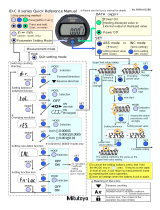 Meiji Techno ID-C X series Owner's manual
Meiji Techno ID-C X series Owner's manual
-
GW Instek LCR-6000 User guide
-
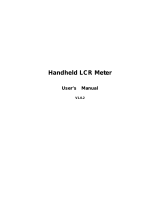 Hantek 1832C User manual
Hantek 1832C User manual
-
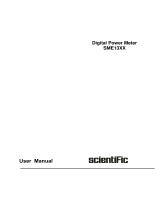 Scientific SME1331 Owner's manual
Scientific SME1331 Owner's manual
-
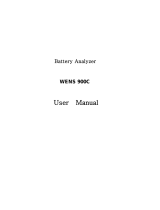 Mitchell Instrument WENS 900C User manual
Mitchell Instrument WENS 900C User manual
-
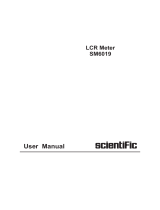 Scientific SM6019 Owner's manual
Scientific SM6019 Owner's manual
-
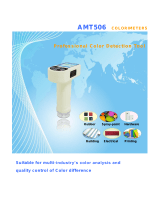 TPM AMT506 User manual
TPM AMT506 User manual
-
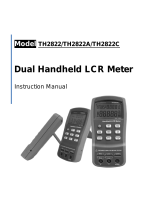 Tonghui TH2822A User manual
Tonghui TH2822A User manual
-
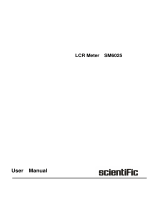 Scientific SM6025 Owner's manual
Scientific SM6025 Owner's manual































































































































































































































































































































































